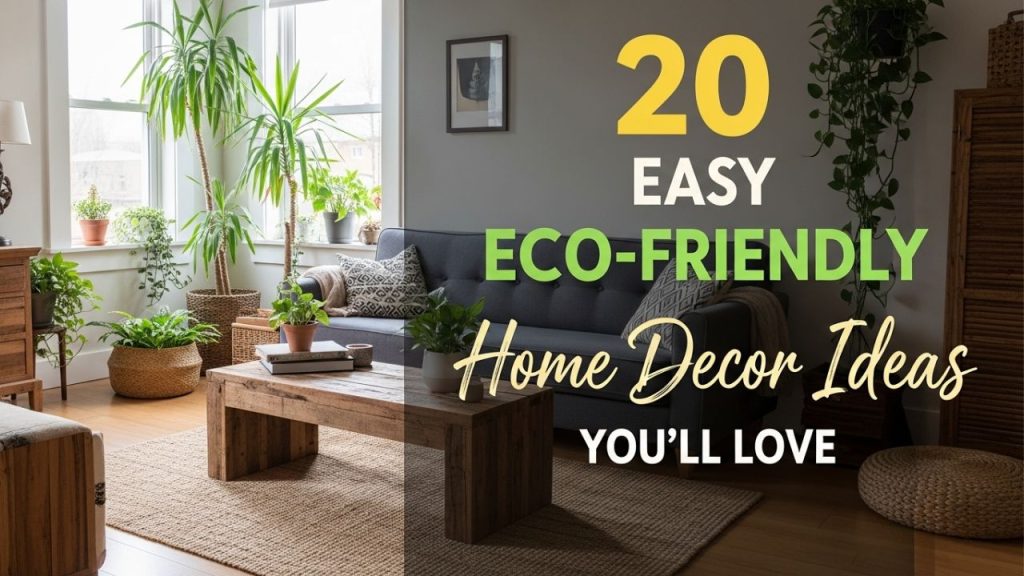When it comes to decorating your home, eco-friendly doesn’t mean dull or expensive. In fact, sustainable decor can bring charm, creativity, and conscious living into every room—without breaking your budget.
If you want to reduce waste, lower your carbon footprint, and still have a beautifully styled space, this list is for you.
Below are 20 practical, stylish, and easy-to-implement eco-friendly home decor ideas—complete with what works, what to avoid, and how to get started.

Table of Contents
1. Use Reclaimed Wood Furniture
Reclaimed wood adds rustic character while reducing the need for new timber.
Why it works: It’s sustainable, durable, and full of unique textures.
How to do it: Look for local artisans or salvage yards. Opt for dining tables, headboards, or open shelves.
Avoid: Using treated or painted reclaimed wood without checking for harmful chemicals.
2. Decorate with Houseplants
Green plants purify the air and bring life into any space.
Why it works: They improve air quality and mood, and require zero waste packaging.
How to do it: Start with easy-care varieties like snake plants or pothos. Group in odd numbers for aesthetic appeal.
Avoid: Overwatering or buying imported, chemically treated plants.
3. Switch to Natural Fiber Rugs
Swap synthetic rugs for jute, cotton, or wool options.
Why it works: Natural fibers are biodegradable and free from plastic-based materials.
How to do it: Choose ethically sourced, handwoven options. Use layered rugs for style.
Avoid: Machine-made versions treated with chemical dyes.
4. DIY with Recycled Materials
Turn jars, pallets, and old containers into statement pieces.
Why it works: Reduces landfill waste and adds unique, handmade character.
How to do it: Use wine bottles as vases or mason jars for candle holders.
Avoid: DIYs that use plastic or synthetic adhesives.
5. Thrift and Upcycle Decor Pieces
Find hidden gems at second-hand stores.
Why it works: Extends the life of objects and reduces demand for new resources.
How to do it: Look for mirrors, lamps, or frames to repaint or reupholster.
Avoid: Impulse buys that you won’t use or don’t match your aesthetic.
6. Choose Low-VOC Paint
Standard paint can release toxins into your home.
Why it works: Low-VOC (Volatile Organic Compound) paint improves indoor air quality.
How to do it: Look for eco-labels like Green Seal or Greenguard Certified.
Avoid: Oil-based paints and synthetic finishes.
7. Use Solar-Powered or LED Lighting
Lighting is a big source of energy use in homes.
Why it works: LED and solar lights use less power and last longer.
How to do it: Replace all bulbs with warm-toned LEDs or install solar garden/path lights.
Avoid: CFL bulbs that contain mercury.
8. Incorporate Bamboo Decor Accents
Bamboo is one of the fastest-growing, renewable materials.
Why it works: It’s lightweight, durable, and grows without fertilizers.
How to do it: Use bamboo blinds, trays, or storage baskets.
Avoid: Heavily varnished bamboo that loses its eco-friendliness.
9. Add Vintage Mirrors to Reflect Light
Mirrors brighten a space without extra lighting.
Why it works: Gives the illusion of a larger space and helps reduce lighting needs.
How to do it: Hang them opposite windows or in darker corners.
Avoid: Buying new plastic-framed mirrors.
10. Use Organic Bedding and Cushions
Your textiles touch your skin daily—make them safe and sustainable.
Why it works: Organic cotton and linen are toxin-free and biodegradable.
How to do it: Choose GOTS-certified bedding or second-hand linens.
Avoid: Polyester blends and fast-fashion decor items.
11. Create a Composting Station for Indoor Plants
Support your indoor greenery with your own compost.
Why it works: Reduces food waste and eliminates the need for chemical fertilizers.
How to do it: Use a small compost bin in the kitchen and rotate it regularly.
Avoid: Adding meat, dairy, or oily foods to indoor compost.
12. Hang Eco-Friendly Curtains
Curtains can insulate your home and elevate your style.
Why it works: Natural fabrics keep your space warm and breathe better.
How to do it: Use linen or cotton curtains and double them for insulation.
Avoid: Synthetic blends or blackout curtains with plastic coatings.
13. Go Minimal With Decor
Less stuff often leads to less waste and more peace.
Why it works: Minimalist decor focuses on intentional design and sustainability.
How to do it: Curate only what brings you joy or utility.
Avoid: Overdecorating or constantly switching trends.
14. Install Water-Saving Fixtures
Sustainability isn’t just what you see—it’s how your home functions.
Why it works: Reduces your water bill and environmental impact.
How to do it: Add aerators to taps and use low-flow showerheads.
Avoid: Ignoring leaks—they waste gallons daily.
15. Make a Gallery Wall with Sustainable Frames
Art can be green too.
Why it works: Eco frames use recycled or responsibly sourced wood.
How to do it: Support local artists or print your own digital downloads.
Avoid: Plastic frames or those with synthetic finishes.
16. Use Scented Soy or Beeswax Candles
Fragrance can be clean, not chemical-laden.
Why it works: These burn cleaner and last longer than paraffin.
How to do it: Buy from local artisans or make your own with essential oils.
Avoid: Candles with synthetic fragrance oils or dyes.
17. Try Furniture Made from Recycled Materials
Innovation meets sustainability in modern furniture.
Why it works: Reduces raw material extraction and promotes circular design.
How to do it: Look for recycled plastic chairs or reclaimed metal tables.
Avoid: Cheap composite boards that break down quickly.
Also Read: 33 Dark Boho-Gothic Home Decor Ideas
18. Upcycle Old Clothes into Decor
Textile waste is a major global issue.
Why it works: Gives old fabrics new life, reducing landfill burden.
How to do it: Turn old saris into cushion covers or patchwork quilts.
Avoid: Using synthetic fabrics that don’t breathe well.
19. Use Eco-Friendly Storage Bins
Organization can be sustainable too.
Why it works: Reduces clutter and reliance on plastic containers.
How to do it: Use woven baskets, metal bins, or wooden crates.
Avoid: Polypropylene boxes or disposable storage bags.
Also Read: 31 Blue Home Decor Ideas for a Royal Touch
20. Support Local & Ethical Brands
Your purchases shape the planet.
Why it works: Shorter supply chains = smaller carbon footprint.
How to do it: Research brands that use eco-certified practices and materials.
Avoid: Fast decor brands that prioritize trend over sustainability.
Final Thoughts
Creating an eco-friendly home doesn’t require a full makeover—just thoughtful swaps and long-term habits. Whether you’re renting a studio apartment or styling a family house, these sustainable decor ideas prove that going green can be beautiful, simple, and smart.
Want more eco-conscious lifestyle tips? Bookmark this post or share with a friend who’s starting their green home journey.








